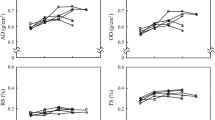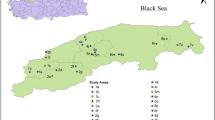Abstract
THE standard method1 of measuring the toxicity of wood preservatives consists of exposing small wood blocks, containing a range of loadings of the preservative, to attack by a specific wood-destroying fungus or insect and noting the loading required to inhibit attack. The blocks are prepared by impregnating them completely with different strength solutions of the preservative in an appropriate volatile solvent which is afterwards allowed to evaporate off. The average concentration of preservative substance left in each block is obtained from the weight of solution absorbed.
This is a preview of subscription content, access via your institution
Access options
Subscribe to this journal
Receive 51 print issues and online access
$199.00 per year
only $3.90 per issue
Buy this article
- Purchase on Springer Link
- Instant access to full article PDF
Prices may be subject to local taxes which are calculated during checkout
Similar content being viewed by others
References
British Standards Institution, B.S. 838 (1939); American Society for Testing Materials, D 1413-56T (1956); Deutscher Normenausschuss, DIN-52 623 (1949).
Cockcroft, R., Wood, 22, 331 (1957).
Becker, G., Holz als Roh- und Werkstoff, 10, 341 (1952).
Bletchly, J. D., and Taylor, J. M., Trans. Eleventh Int. Congr. Ent. Vienna (1960).
Author information
Authors and Affiliations
Rights and permissions
About this article
Cite this article
SMITH, D., COCKCROFT, R. A Method of obtaining Uniform Distribution of Wood Preservatives in Toxicity Test Blocks. Nature 189, 163–164 (1961). https://doi.org/10.1038/189163a0
Issue Date:
DOI: https://doi.org/10.1038/189163a0
This article is cited by
-
The influence of curing conditions on the chemical distribution in wood modified with thermosetting resins
Wood Science and Technology (2013)
Comments
By submitting a comment you agree to abide by our Terms and Community Guidelines. If you find something abusive or that does not comply with our terms or guidelines please flag it as inappropriate.



